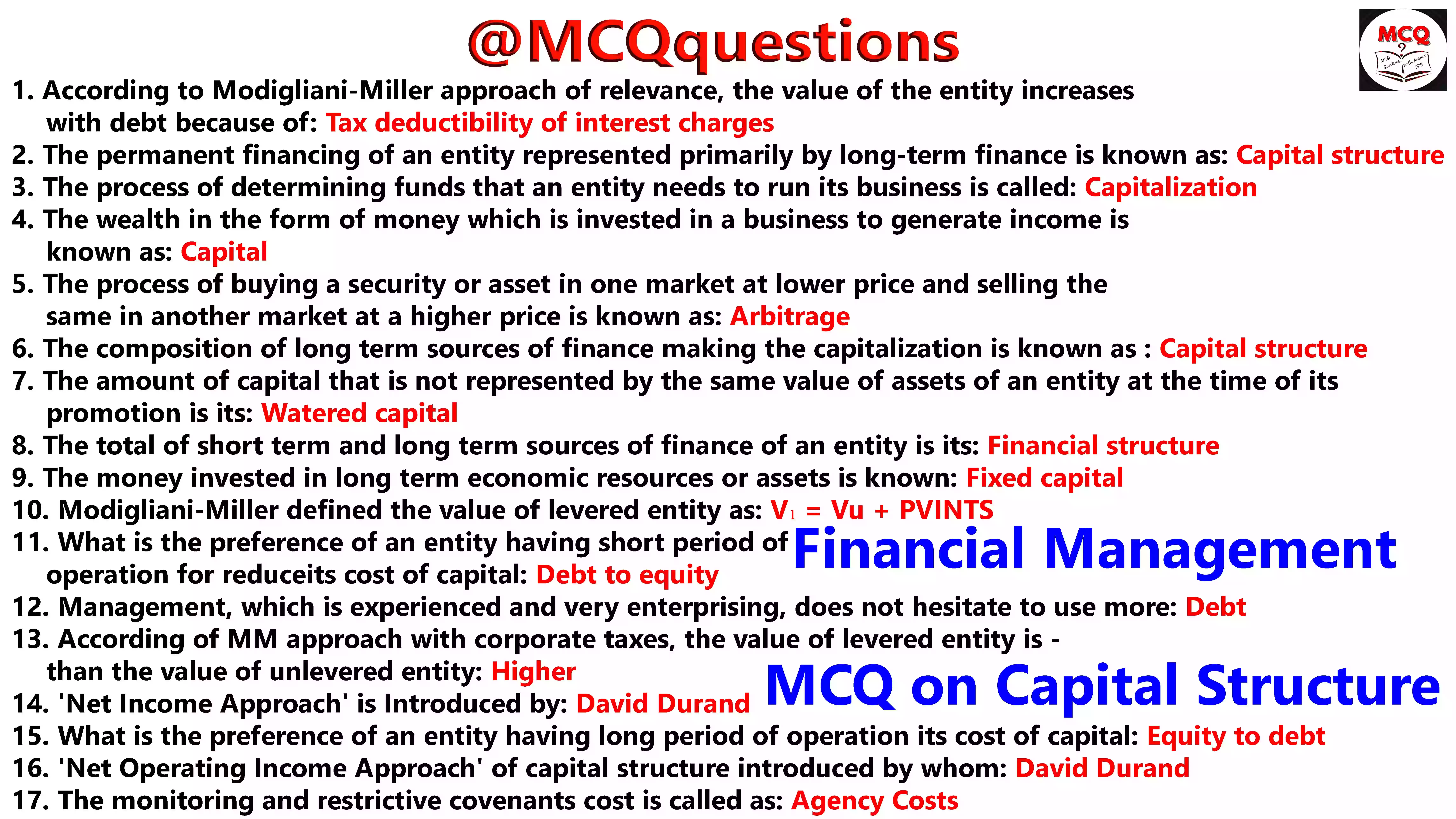Financial Management MCQ on Capital Structure

Financial Management MCQ on Capital Structure
1. According to Modigliani-Miller approach of relevance, the value of the entity increases
with debt because of:
(a) Stability
(b) High earnings
(c) Low risk
(d) Tax deductibility of interest charges
Ans-(d) Tax deductibility of interest charges
2. The permanent financing of an entity represented primarily by long-term finance is known as:
(a) Capital structure
(b) Working capital
(c) Financial structure
(d) Watered capital
Ans-(a) Capital structure
3. The process of determining funds that an entity needs to run its business is called
(a) Capitalization
(b) Quantitative analysis
(c) Financing
(d) Utilisation
Ans-(a) Capitalization
4. The wealth in the form of money which is invested in a business to generate income is
known as:
(a) Capital
(b) Insurance
(c) Value
(d) Donation
Ans-(a) Capital
5. The process of buying a security or asset in one market at lower price and selling the
same in another market at a higher price is known as:
(a) Bargaining
(b) Insider trading
(c) Arbitrage
(d) None of these
Ans-(c) Arbitrage
6. The composition of long term sources of finance making the capitalization is known as
(a) Financial structure
(b) Market Structure
(c) Capital structure
(d) None of these
Ans-(c) Capital structure
7. The amount of capital that is not represented by the same value of assets of an entity at the time of its promotion is its:
(a) Promotion capital
(b) Fixed capital
(c) Working capital
(d) Watered capital
Ans-(d) Watered capital
8. The main factors which affect the capital structure decision of an entity are:
(a) Financial Leverage
(b) Cost of Capital
(c) Nature of Assets
(d) All of these
Ans-(d) All of these
9. The total of short term and long term sources of finance of an entity is its:
(a) Capital structure
(b) Financial structure
(c) Money Structure
(d) Short term structure
Ans-(b) Financial structure
10. The money invested in long term economic resources or assets is known
(a) Working capital
(b) Share Capital
(c) Fixed capital
(d) Debenture Capital
Ans-(c) Fixed capital
11. Modigliani-Miller defined the value of levered entity as:
(a) V₁ = Vu + PVINTS
(c) V = Vu + INTS
(b) V=Vu-PVINTS
(d) None of these
Ans-(a) V₁ = Vu + PVINTS
12. What is the preference of an entity having short period of operation for reduce
its cost of capital?
(a) Derivatives to debt
(b) Equity to debt
(c) Debt to equity
(d) None of these
Ans-(c) Debt to equity
13. Management, which is experienced and very enterprising, does not hesitate to use more
(a) Debt
(b) Earnings
(c) Equity
(d) None of these
Ans-(a) Debt
14. According of MM approach with corporate taxes, the value of levered entity is –
than the value of unlevered entity.
(a) Lower
(b) Slightly lower
(c) Higher
(d) Normal
Ans-(c) Higher
15. ‘Net Income Approach’ is Introduced by
(a) Modigliani
(b) David Durand
(c) Miller
(d) Sachin Tendulkar
Ans-(b) David Durand
16. The costs are associated with the negative effect of the threat of bankruptcy on sales and
normal operations of business are known as:
(a) Direct Bankruptcy Costs
(b) Solvency costs
(c) Indirect Bankruptcy Costs
(d) None of these
Ans-(c) Indirect Bankruptcy Costs
17. What is the preference of an entity having long period of operation its cost of capital?
(a) Equity to debt
(b) Derivatives to debt
(c) Debt to equity
(d) None of these
Ans-(a) Equity to debt
18. Which of the following equation indicating the impact of bankruptcy
(a) V₁ = Vu + Vd + BC
(b) V₁ = Vu + Vd – BC
(c) V₁ = Vu – BC
(d) None of these
Ans-(b) V₁ = Vu + Vd - BC
19. The traditional approach of capital structure contains the features of:
(a) Net Operating Income Approach
(b) Net Income Approach
(c) Both of these
(d) None of these
Ans-(c) Both of these
20. ‘Net Operating Income Approach’ of capital structure introduced by whom?
(a) Modigliani
(b) Miller
(c) David Durand
(d) Ricky Ponting
Ans-(c) David Durand
21. The monitoring and restrictive covenants cost is called as ?
(a) Solvency Cost
(b) Bankruptcy Cost
(c) Monitoring Cost
(d) Agency Costs
Ans-(d) Agency Costs
22. The problems arising due to conflict of interest among equity shareholders, shareholders, debentures holders and management is:
(a) Bankruptcy Problems
(b) Public Problems
(c) Agency problems
(d) Share holder problems
Ans-(c) Agency problems
23. The entities issuing excessive debts have high probability of financial distress which …….their value.
(a) Normal
(b) Does not change
(c) Increases
(d) Reduces
Ans-(d) Reduces
Also Read Financial Management MCQ
